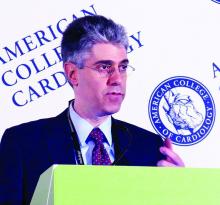User login
Catherine Hackett is editor of MDedge's Cardiology News and Clinical Endocrinology News. She joined the company in 2003. Before that, she was a researcher and managing editor for Time-Life Books, a fact checker for Smithsonian Magazine, and a technical editor at the American Journal of Clinical Nutrition.
Novel agent to be studied in relapsed/refractory AML
Trovagene announced.
The aim of the phase 1 portion of the trial is to find out whether PCM-075 given orally daily for 5 consecutive days every 28 days is safe and tolerable in such patients or in those AML patients who are ineligible for intensive induction therapy. The researchers are also trying to determine the maximum tolerated dose of PCM-075 or recommended phase 2 dose of PCM-075 in combination with decitabine and/or PCM-075 in combination with low-dose cytarabine.
The primary outcomes of the phase 1 portion of the trial are the number of participants with dose-limiting toxicity and adverse events from baseline out to 30 days after the last dose of PCM-075, up to 27 months. The primary outcome of phase 2 , called PCM-075 in Combination With Either Low-Dose Cytarabine or Decitabine in Adult Patients With Acute Myeloid Leukemia, will be the rate of complete response plus complete response with incomplete blood count recovery out to 27 months.
The PLK1 enzyme is overexpressed in multiple hematologic and solid tumor cancers, and studies have shown that inhibition of polo-like kinases can lead to tumor cell death, Trovagene said in its statement.
Bill Welch, CEO of Trovagene, added that “PCM-075 is the first highly PLK1-selective competitive inhibitor administered orally to enter clinical trials with potential activity in both hematologic and solid tumor cancers.”
Trovagene announced.
The aim of the phase 1 portion of the trial is to find out whether PCM-075 given orally daily for 5 consecutive days every 28 days is safe and tolerable in such patients or in those AML patients who are ineligible for intensive induction therapy. The researchers are also trying to determine the maximum tolerated dose of PCM-075 or recommended phase 2 dose of PCM-075 in combination with decitabine and/or PCM-075 in combination with low-dose cytarabine.
The primary outcomes of the phase 1 portion of the trial are the number of participants with dose-limiting toxicity and adverse events from baseline out to 30 days after the last dose of PCM-075, up to 27 months. The primary outcome of phase 2 , called PCM-075 in Combination With Either Low-Dose Cytarabine or Decitabine in Adult Patients With Acute Myeloid Leukemia, will be the rate of complete response plus complete response with incomplete blood count recovery out to 27 months.
The PLK1 enzyme is overexpressed in multiple hematologic and solid tumor cancers, and studies have shown that inhibition of polo-like kinases can lead to tumor cell death, Trovagene said in its statement.
Bill Welch, CEO of Trovagene, added that “PCM-075 is the first highly PLK1-selective competitive inhibitor administered orally to enter clinical trials with potential activity in both hematologic and solid tumor cancers.”
Trovagene announced.
The aim of the phase 1 portion of the trial is to find out whether PCM-075 given orally daily for 5 consecutive days every 28 days is safe and tolerable in such patients or in those AML patients who are ineligible for intensive induction therapy. The researchers are also trying to determine the maximum tolerated dose of PCM-075 or recommended phase 2 dose of PCM-075 in combination with decitabine and/or PCM-075 in combination with low-dose cytarabine.
The primary outcomes of the phase 1 portion of the trial are the number of participants with dose-limiting toxicity and adverse events from baseline out to 30 days after the last dose of PCM-075, up to 27 months. The primary outcome of phase 2 , called PCM-075 in Combination With Either Low-Dose Cytarabine or Decitabine in Adult Patients With Acute Myeloid Leukemia, will be the rate of complete response plus complete response with incomplete blood count recovery out to 27 months.
The PLK1 enzyme is overexpressed in multiple hematologic and solid tumor cancers, and studies have shown that inhibition of polo-like kinases can lead to tumor cell death, Trovagene said in its statement.
Bill Welch, CEO of Trovagene, added that “PCM-075 is the first highly PLK1-selective competitive inhibitor administered orally to enter clinical trials with potential activity in both hematologic and solid tumor cancers.”
Start with fitness when deciding on treatment for elderly AML patients
When evaluating older patients with acute myeloid leukemia for treatment, start with their fitness levels.
ML is a disease of older adults, and with increasing age comes higher treatment-related mortality, lower complete remission rates, higher relapse risk, and shorter overall survival. So it may not be surprising that fewer than half of U.S. patients with newly diagnosed acute myeloid leukemia over age 65 receive any chemotherapy at all, wrote Li-Wen Huang, MD, and Rebecca L. Olin, MD, of the University of California, San Francisco.
Fitness is key: Older patients considered fit for intensive chemotherapy should receive standard induction therapy, and reduced-intensity allogeneic stem cell transplantation should then be considered. Patients considered unfit for intensive therapy, on the other hand, should receive hypomethylating agents.
Several new therapeutic agents have shown promising results either by improving intensive chemotherapy (CPX-351), by improving upon lower-intensity therapy (venetoclax, antibody drug conjugates), or by targeting somatic mutations (FLT3 inhibitors and others), the investigators concluded.
Dr. Huang reported no conflicts. Dr. Olin has received research funding from Daiichi Sankyo, Astellas, and Genentech.
When evaluating older patients with acute myeloid leukemia for treatment, start with their fitness levels.
ML is a disease of older adults, and with increasing age comes higher treatment-related mortality, lower complete remission rates, higher relapse risk, and shorter overall survival. So it may not be surprising that fewer than half of U.S. patients with newly diagnosed acute myeloid leukemia over age 65 receive any chemotherapy at all, wrote Li-Wen Huang, MD, and Rebecca L. Olin, MD, of the University of California, San Francisco.
Fitness is key: Older patients considered fit for intensive chemotherapy should receive standard induction therapy, and reduced-intensity allogeneic stem cell transplantation should then be considered. Patients considered unfit for intensive therapy, on the other hand, should receive hypomethylating agents.
Several new therapeutic agents have shown promising results either by improving intensive chemotherapy (CPX-351), by improving upon lower-intensity therapy (venetoclax, antibody drug conjugates), or by targeting somatic mutations (FLT3 inhibitors and others), the investigators concluded.
Dr. Huang reported no conflicts. Dr. Olin has received research funding from Daiichi Sankyo, Astellas, and Genentech.
When evaluating older patients with acute myeloid leukemia for treatment, start with their fitness levels.
ML is a disease of older adults, and with increasing age comes higher treatment-related mortality, lower complete remission rates, higher relapse risk, and shorter overall survival. So it may not be surprising that fewer than half of U.S. patients with newly diagnosed acute myeloid leukemia over age 65 receive any chemotherapy at all, wrote Li-Wen Huang, MD, and Rebecca L. Olin, MD, of the University of California, San Francisco.
Fitness is key: Older patients considered fit for intensive chemotherapy should receive standard induction therapy, and reduced-intensity allogeneic stem cell transplantation should then be considered. Patients considered unfit for intensive therapy, on the other hand, should receive hypomethylating agents.
Several new therapeutic agents have shown promising results either by improving intensive chemotherapy (CPX-351), by improving upon lower-intensity therapy (venetoclax, antibody drug conjugates), or by targeting somatic mutations (FLT3 inhibitors and others), the investigators concluded.
Dr. Huang reported no conflicts. Dr. Olin has received research funding from Daiichi Sankyo, Astellas, and Genentech.
FROM THE JOURNAL OF GERIATRIC ONCOLOGY
Late-Breaking Science preview: Wednesday, Nov. 15
The final Late-Breaking Science session delves into innovative therapies and novel applications, including two phase 1-2 stem cell trials, an early trial in toxin treatments to prevent atrial fibrillation, a phase 1 test of an interatrial shunt device for heart failure with preserved ejection fraction, and more:
- TNT-POAF: Nathan Waldron, MD, of Duke University, Durham, N.C., will present results of a trial aiming to prevent postoperative atrial fibrillation with the use of temporary toxin treatment.
- REDUCE LAP–HF 1: In what the investigators call the first randomized controlled trial of a device-based therapy to reduce left atrial pressure in HFpEF, an inter-atrial shunt device designed to provide continuous and dynamic decompression of the left atrium. Sanjiv J Shah, MD, of Northwestern University will present the study, which holds the hypothesis that the device may reduce symptoms and slow the progression of heart failure.
- PROPEL: This study tested the hypothesis that granulocyte-macrophage colony-stimulating factor (GM-CSF) combined with supervised treadmill exercise in patients with peripheral artery disease would significantly improve functional performance more than GM-CSF alone or supervised treadmill exercise alone. Mary McDermott, MD, of Northwestern University, Chicago, will present the primary endpoint of change in 6-minute walk performance at 12-weeks’ follow-up, as well as several secondary outcomes.
- ALLSTAR: Timothy Henry, MD, of the Cedars-Sinai Heart Institute, Los Angeles, will present the phase 1-2 ALLSTAR (Allogeneic Heart Stem Cells to Achieve Myocardial Regeneration) study, which compared allogeneic cardiosphere-derived cells (CAP-1002) to placebo in order to find whether it is safe and effective in decreasing infarct size in patients with an MI.
- HOPE-Duchenne: This phase 1-2 study randomized men with cardiomyopathy secondary to Duchenne muscular dystrophy to receive CAP-1002 cells or usual care; its primary outcome is safety. Ronald Victor, MD, will present the results.
[email protected]
On Twitter @cardionews
The final Late-Breaking Science session delves into innovative therapies and novel applications, including two phase 1-2 stem cell trials, an early trial in toxin treatments to prevent atrial fibrillation, a phase 1 test of an interatrial shunt device for heart failure with preserved ejection fraction, and more:
- TNT-POAF: Nathan Waldron, MD, of Duke University, Durham, N.C., will present results of a trial aiming to prevent postoperative atrial fibrillation with the use of temporary toxin treatment.
- REDUCE LAP–HF 1: In what the investigators call the first randomized controlled trial of a device-based therapy to reduce left atrial pressure in HFpEF, an inter-atrial shunt device designed to provide continuous and dynamic decompression of the left atrium. Sanjiv J Shah, MD, of Northwestern University will present the study, which holds the hypothesis that the device may reduce symptoms and slow the progression of heart failure.
- PROPEL: This study tested the hypothesis that granulocyte-macrophage colony-stimulating factor (GM-CSF) combined with supervised treadmill exercise in patients with peripheral artery disease would significantly improve functional performance more than GM-CSF alone or supervised treadmill exercise alone. Mary McDermott, MD, of Northwestern University, Chicago, will present the primary endpoint of change in 6-minute walk performance at 12-weeks’ follow-up, as well as several secondary outcomes.
- ALLSTAR: Timothy Henry, MD, of the Cedars-Sinai Heart Institute, Los Angeles, will present the phase 1-2 ALLSTAR (Allogeneic Heart Stem Cells to Achieve Myocardial Regeneration) study, which compared allogeneic cardiosphere-derived cells (CAP-1002) to placebo in order to find whether it is safe and effective in decreasing infarct size in patients with an MI.
- HOPE-Duchenne: This phase 1-2 study randomized men with cardiomyopathy secondary to Duchenne muscular dystrophy to receive CAP-1002 cells or usual care; its primary outcome is safety. Ronald Victor, MD, will present the results.
[email protected]
On Twitter @cardionews
The final Late-Breaking Science session delves into innovative therapies and novel applications, including two phase 1-2 stem cell trials, an early trial in toxin treatments to prevent atrial fibrillation, a phase 1 test of an interatrial shunt device for heart failure with preserved ejection fraction, and more:
- TNT-POAF: Nathan Waldron, MD, of Duke University, Durham, N.C., will present results of a trial aiming to prevent postoperative atrial fibrillation with the use of temporary toxin treatment.
- REDUCE LAP–HF 1: In what the investigators call the first randomized controlled trial of a device-based therapy to reduce left atrial pressure in HFpEF, an inter-atrial shunt device designed to provide continuous and dynamic decompression of the left atrium. Sanjiv J Shah, MD, of Northwestern University will present the study, which holds the hypothesis that the device may reduce symptoms and slow the progression of heart failure.
- PROPEL: This study tested the hypothesis that granulocyte-macrophage colony-stimulating factor (GM-CSF) combined with supervised treadmill exercise in patients with peripheral artery disease would significantly improve functional performance more than GM-CSF alone or supervised treadmill exercise alone. Mary McDermott, MD, of Northwestern University, Chicago, will present the primary endpoint of change in 6-minute walk performance at 12-weeks’ follow-up, as well as several secondary outcomes.
- ALLSTAR: Timothy Henry, MD, of the Cedars-Sinai Heart Institute, Los Angeles, will present the phase 1-2 ALLSTAR (Allogeneic Heart Stem Cells to Achieve Myocardial Regeneration) study, which compared allogeneic cardiosphere-derived cells (CAP-1002) to placebo in order to find whether it is safe and effective in decreasing infarct size in patients with an MI.
- HOPE-Duchenne: This phase 1-2 study randomized men with cardiomyopathy secondary to Duchenne muscular dystrophy to receive CAP-1002 cells or usual care; its primary outcome is safety. Ronald Victor, MD, will present the results.
[email protected]
On Twitter @cardionews
Late-Breaking Science preview: Tuesday, Nov. 14
On the third day of the American Heart Association scientific sessions, antithrombotic therapy is the focus of the Late-Breaking Science 5 presentation, at 10:45 a.m.-12 p.m. on Tuesday, Nov. 14, followed by innovative investigations in evaluating quality improvement and patient-centered care interventions in the Late-Breaking Science 6 session, to be held at 3:45-5:15 p.m. Here are some highlights.
Late-Breaking Science 5, antithrombotic therapy
- RE-DUAL PCI: Jonas Oldgren, MD, of Uppsala (Sweden) University, will present an unspecified subgroup analysis from the RE-DUAL PCI (Dual Antithrombotic Therapy With Dabigatran in Patients With Atrial Fibrillation Undergoing Percutaneous Coronary Intervention) trial, focusing on one arm of the study. The main results, presented in August, showed patients with atrial fibrillation who had undergone percutaneous coronary intervention had a lower risk of bleeding if they received dual therapy with dabigatran plus clopidogrel or ticagrelor than did those treated with warfarin, clopidogrel, or ticagrelor.
- POISE-2 PCI: Michelle M. Graham, MD, of the University of Alberta, Edmonton, will present a substudy of POISE-2 focusing on the patients in undergoing noncardiac surgery who had a previous percutaneous coronary intervention. POISE-2, published in 2014, showed that administering aspirin periprocedurally had no effect on the rate of a composite of death or nonfatal MI, but increased the risk of major bleeding.
Dr. Jonas Oldgren - GEMINI-ACS-1: In the main study, the risk of major bleeding was similar between ACS patients treated with a combination of low-dose rivaroxaban and a P2Y12 inhibitor and those treated with aspirin and P2Y12 inhibitor. Matthew T. Roe, MD, Duke Clinical Research Institute, Durham, N.C., will present the substudy focusing on P2Y12 inhibitor switching in response to routine notification of CYP2C19 clopidogrel metabolizer status following ACS.
- PRAGUE-18: Zuzana Motovska, MD, of Charles University in Prague, will present an unspecified substudy of PRAGUE-18, which in August 2016 showed no difference in safety or efficacy between prasugrel and ticagrelor in AMI patients undergoing primary angioplasty.
Late-Breaking Session 6, quality improvement and patient-centered care
The seven presentations in this session range from findings from the enormous SWEDEHEART registry on how treatments have improved for ST-elevation MI over 20 years, to STIC2IT, a cluster randomized, controlled trial to test whether a novel telepharmacist-based intervention for patients with metabolic syndrome improves medication adherence and disease control.
Other presentations include evaluation of a quality improvement toolkit on AMI in India called ACS QUIK; a trial of a decision support intervention for patients and caregivers offered a heart assist device as destination therapy called DECIDE-LVAD; a national rollout of a clinical guidance framework for the assessment of patients with possible ACS in emergency departments (iCARE-ACS); and a report from the American College of Cardiology’s Mission: Lifeline STEMI ACCELERATOR-2 study.
[email protected]
On Twitter @cardionews
On the third day of the American Heart Association scientific sessions, antithrombotic therapy is the focus of the Late-Breaking Science 5 presentation, at 10:45 a.m.-12 p.m. on Tuesday, Nov. 14, followed by innovative investigations in evaluating quality improvement and patient-centered care interventions in the Late-Breaking Science 6 session, to be held at 3:45-5:15 p.m. Here are some highlights.
Late-Breaking Science 5, antithrombotic therapy
- RE-DUAL PCI: Jonas Oldgren, MD, of Uppsala (Sweden) University, will present an unspecified subgroup analysis from the RE-DUAL PCI (Dual Antithrombotic Therapy With Dabigatran in Patients With Atrial Fibrillation Undergoing Percutaneous Coronary Intervention) trial, focusing on one arm of the study. The main results, presented in August, showed patients with atrial fibrillation who had undergone percutaneous coronary intervention had a lower risk of bleeding if they received dual therapy with dabigatran plus clopidogrel or ticagrelor than did those treated with warfarin, clopidogrel, or ticagrelor.
- POISE-2 PCI: Michelle M. Graham, MD, of the University of Alberta, Edmonton, will present a substudy of POISE-2 focusing on the patients in undergoing noncardiac surgery who had a previous percutaneous coronary intervention. POISE-2, published in 2014, showed that administering aspirin periprocedurally had no effect on the rate of a composite of death or nonfatal MI, but increased the risk of major bleeding.
Dr. Jonas Oldgren - GEMINI-ACS-1: In the main study, the risk of major bleeding was similar between ACS patients treated with a combination of low-dose rivaroxaban and a P2Y12 inhibitor and those treated with aspirin and P2Y12 inhibitor. Matthew T. Roe, MD, Duke Clinical Research Institute, Durham, N.C., will present the substudy focusing on P2Y12 inhibitor switching in response to routine notification of CYP2C19 clopidogrel metabolizer status following ACS.
- PRAGUE-18: Zuzana Motovska, MD, of Charles University in Prague, will present an unspecified substudy of PRAGUE-18, which in August 2016 showed no difference in safety or efficacy between prasugrel and ticagrelor in AMI patients undergoing primary angioplasty.
Late-Breaking Session 6, quality improvement and patient-centered care
The seven presentations in this session range from findings from the enormous SWEDEHEART registry on how treatments have improved for ST-elevation MI over 20 years, to STIC2IT, a cluster randomized, controlled trial to test whether a novel telepharmacist-based intervention for patients with metabolic syndrome improves medication adherence and disease control.
Other presentations include evaluation of a quality improvement toolkit on AMI in India called ACS QUIK; a trial of a decision support intervention for patients and caregivers offered a heart assist device as destination therapy called DECIDE-LVAD; a national rollout of a clinical guidance framework for the assessment of patients with possible ACS in emergency departments (iCARE-ACS); and a report from the American College of Cardiology’s Mission: Lifeline STEMI ACCELERATOR-2 study.
[email protected]
On Twitter @cardionews
On the third day of the American Heart Association scientific sessions, antithrombotic therapy is the focus of the Late-Breaking Science 5 presentation, at 10:45 a.m.-12 p.m. on Tuesday, Nov. 14, followed by innovative investigations in evaluating quality improvement and patient-centered care interventions in the Late-Breaking Science 6 session, to be held at 3:45-5:15 p.m. Here are some highlights.
Late-Breaking Science 5, antithrombotic therapy
- RE-DUAL PCI: Jonas Oldgren, MD, of Uppsala (Sweden) University, will present an unspecified subgroup analysis from the RE-DUAL PCI (Dual Antithrombotic Therapy With Dabigatran in Patients With Atrial Fibrillation Undergoing Percutaneous Coronary Intervention) trial, focusing on one arm of the study. The main results, presented in August, showed patients with atrial fibrillation who had undergone percutaneous coronary intervention had a lower risk of bleeding if they received dual therapy with dabigatran plus clopidogrel or ticagrelor than did those treated with warfarin, clopidogrel, or ticagrelor.
- POISE-2 PCI: Michelle M. Graham, MD, of the University of Alberta, Edmonton, will present a substudy of POISE-2 focusing on the patients in undergoing noncardiac surgery who had a previous percutaneous coronary intervention. POISE-2, published in 2014, showed that administering aspirin periprocedurally had no effect on the rate of a composite of death or nonfatal MI, but increased the risk of major bleeding.
Dr. Jonas Oldgren - GEMINI-ACS-1: In the main study, the risk of major bleeding was similar between ACS patients treated with a combination of low-dose rivaroxaban and a P2Y12 inhibitor and those treated with aspirin and P2Y12 inhibitor. Matthew T. Roe, MD, Duke Clinical Research Institute, Durham, N.C., will present the substudy focusing on P2Y12 inhibitor switching in response to routine notification of CYP2C19 clopidogrel metabolizer status following ACS.
- PRAGUE-18: Zuzana Motovska, MD, of Charles University in Prague, will present an unspecified substudy of PRAGUE-18, which in August 2016 showed no difference in safety or efficacy between prasugrel and ticagrelor in AMI patients undergoing primary angioplasty.
Late-Breaking Session 6, quality improvement and patient-centered care
The seven presentations in this session range from findings from the enormous SWEDEHEART registry on how treatments have improved for ST-elevation MI over 20 years, to STIC2IT, a cluster randomized, controlled trial to test whether a novel telepharmacist-based intervention for patients with metabolic syndrome improves medication adherence and disease control.
Other presentations include evaluation of a quality improvement toolkit on AMI in India called ACS QUIK; a trial of a decision support intervention for patients and caregivers offered a heart assist device as destination therapy called DECIDE-LVAD; a national rollout of a clinical guidance framework for the assessment of patients with possible ACS in emergency departments (iCARE-ACS); and a report from the American College of Cardiology’s Mission: Lifeline STEMI ACCELERATOR-2 study.
[email protected]
On Twitter @cardionews
Late-Breaking Science preview: Monday, Nov. 13
Analyses of landmark, practice-changing trials will pepper the three late-breaking science sessions.
Late-Breaking Science 2
The Late-Breaking Science 2 session will focus on prevention and will include analyses from the two most illuminating and perhaps practice-changing trials presented this year, FOURIER and CANTOS. REVEAL, another large and important trial of 2017, also spawned a subanalysis in this deep-diving session at 9:00 a.m.-10:15 a.m.:
- REAL-CAD: This study evaluated the prevention of cardiovascular disease with pitavastatin 1 mg/day or 4 mg/day in patients with stable coronary artery disease followed for 3-6 years. In the REAL-CAD (Randomized Evaluation of Aggressive or Moderate Lipid Lowering Therapy With Pitavastatin in Coronary Artery Disease) trial, presented by Takeshi Kimura, MD, of Kyoto (Japan) University, the primary endpoint was the occurrence of cardiovascular death, nonfatal MI, nonfatal cerebral infarction, or unstable angina.
- REVEAL: Presented in August at the European Society of Cardiology Congress (ESC), the primary results of REVEAL (Randomized Evaluation of the Effects of Anacetrapib Through Lipid-Modification), a multicenter, pivotal trial with more than 30,000 patients treated for about 4 years, showed that patients treated with anacetrapib had a statistically significant 9% decrease in major coronary events, compared with placebo-treated controls. The analysis to be presented at AHA by Martin Landrey, MD of the University of Oxford, England, examined the effects of anacetrapib on the incidence of new-onset diabetes and on vascular events in people with diabetes. Frontline Medical News
Dr. Paul M. Ridker - FOURIER: This blockbuster trial in more than 27,000 patients showed that the PCSK9 inhibitor evolocumab significantly improved cardiovascular outcomes in high-risk patients already on statin therapy and has already started spawning important subanalyses. Two will be presented in this session. First, Marc P. Bonaca, MD, of Brigham & Women’s Hospital in Boston, will present outcomes in patients with peripheral artery disease. Second, Marc S. Sabatine, MD, also of Brigham & Women’s, will present the clinical benefit of evolocumab in patients with a history of MI.
Dr. Marc S. Sabatine - CANTOS: The findings of CANTOS (Canakinumab Anti-Inflammatory Thrombosis Outcome Study) stunned the cardiovascular world and piqued interest in their oncology colleagues. “These data provide the first proof that inflammation inhibition in the absence of lipid lowering can improve atherogenic outcomes and potentially alter progression of some fatal cancers,” declared Paul M. Ridker, MD, of Brigham and Women’s Hospital and professor of medicine at Harvard Medical School, both in Boston, at ESC. In CANTOS, the fully human monoclonal antibody canakinumab, which targets IL-1B, reduced the risk of recurrent cardiovascular events by 15% in a very-high-risk population, compared with placebo, while cutting incident lung cancer by 67%.
Late-Breaking Science 3
This session promises insights into hypertension management and will be held at 10:45 a.m.-12:00 p.m.:
- Chinese BP trial: Presented by Mar Pujades-Rodriguez, PhD, of the University of Leeds, (England), this study examined time at blood pressure target and the risk of cardiovascular diseases and mortality in a Chinese population.
- SPRINT: Yes, the trial that upended hypertension guidelines is bearing fruit again. This analysis of SPRINT (Systolic Blood Pressure Intervention Trial) looked at blood pressure measurement. Karen C. Johnson, MD, of the University of Tennessee, Memphis, will present the results.
Dr. Robert J. Mentz - GATEWAY: As the benefits of bariatric surgery seem to pile up, the GATEWAY (Gastric Bypass to Treat Obese Patients With Steady Hypertension) trial focused on reducing the need for antihypertensive drugs and decreasing systemic arterial blood pressure and other risk factors for cardiovascular events in patients with arterial hypertension randomized to Roux-en-Y gastroplasty or to clinical treatments. Carlos A. Schiavon, MD, of Heart Hospital in São Paulo will present the results.
Late-Breaking Science 4
Billed as covering the “sweet spot in cardiometabolic care,” this session will highlight new findings from three of the biggest trials in type 2 diabetes management. The session will run at 3:45 p.m.-5:00 p.m.
- CANVAS: Presented at ESC, the results of this large, FDA-mandated cardiovascular outcomes trial showed that canagliflozin significantly reduced the risk of cardiovascular and renal events but doubled the risk of amputation, compared with placebo, in patients with type 2 diabetes. In this subanalysis of CANVAS (the Canagliflozin Cardiovascular Assessment Study), presenter Kenneth W. Mahaffey, MD, of Stanford (Calif.) University, and his coinvestigators looked at primary and secondary prevention of cardiovascular events in the same population.Sara Freeman/Frontline Medical News
Dr. Bernard Zinman - EXSCEL: The results of this trial, also presented at ESC, showed that exenatide was noninferior to placebo with respect to cardiovascular safety but not superior with respect to efficacy. Presenter Robert J. Mentz, MD, of Duke University, Durham, N.C., will present more news from the EXSCEL (Exenatide Study of Cardiovascular Event Lowering) trial.
- EMPA-REG OUTCOME: The first trial to show a cardioprotective effect of an SGLT-2 inhibitor in type 2 diabetes patients, EMPA-REG OUTCOME, marked a new era in diabetes treatment. Bernard Zinman, MD, of the University of Toronto, will present an subset analysis of patients with type 2 diabetes and peripheral artery disease. The session title signals more good news: Empagliflozin Reduces Mortality and Hospitalization for Heart Failure in Patients With Type 2 Diabetes and Peripheral Artery Disease.
[email protected]
On Twitter @cardionews
Analyses of landmark, practice-changing trials will pepper the three late-breaking science sessions.
Late-Breaking Science 2
The Late-Breaking Science 2 session will focus on prevention and will include analyses from the two most illuminating and perhaps practice-changing trials presented this year, FOURIER and CANTOS. REVEAL, another large and important trial of 2017, also spawned a subanalysis in this deep-diving session at 9:00 a.m.-10:15 a.m.:
- REAL-CAD: This study evaluated the prevention of cardiovascular disease with pitavastatin 1 mg/day or 4 mg/day in patients with stable coronary artery disease followed for 3-6 years. In the REAL-CAD (Randomized Evaluation of Aggressive or Moderate Lipid Lowering Therapy With Pitavastatin in Coronary Artery Disease) trial, presented by Takeshi Kimura, MD, of Kyoto (Japan) University, the primary endpoint was the occurrence of cardiovascular death, nonfatal MI, nonfatal cerebral infarction, or unstable angina.
- REVEAL: Presented in August at the European Society of Cardiology Congress (ESC), the primary results of REVEAL (Randomized Evaluation of the Effects of Anacetrapib Through Lipid-Modification), a multicenter, pivotal trial with more than 30,000 patients treated for about 4 years, showed that patients treated with anacetrapib had a statistically significant 9% decrease in major coronary events, compared with placebo-treated controls. The analysis to be presented at AHA by Martin Landrey, MD of the University of Oxford, England, examined the effects of anacetrapib on the incidence of new-onset diabetes and on vascular events in people with diabetes. Frontline Medical News
Dr. Paul M. Ridker - FOURIER: This blockbuster trial in more than 27,000 patients showed that the PCSK9 inhibitor evolocumab significantly improved cardiovascular outcomes in high-risk patients already on statin therapy and has already started spawning important subanalyses. Two will be presented in this session. First, Marc P. Bonaca, MD, of Brigham & Women’s Hospital in Boston, will present outcomes in patients with peripheral artery disease. Second, Marc S. Sabatine, MD, also of Brigham & Women’s, will present the clinical benefit of evolocumab in patients with a history of MI.
Dr. Marc S. Sabatine - CANTOS: The findings of CANTOS (Canakinumab Anti-Inflammatory Thrombosis Outcome Study) stunned the cardiovascular world and piqued interest in their oncology colleagues. “These data provide the first proof that inflammation inhibition in the absence of lipid lowering can improve atherogenic outcomes and potentially alter progression of some fatal cancers,” declared Paul M. Ridker, MD, of Brigham and Women’s Hospital and professor of medicine at Harvard Medical School, both in Boston, at ESC. In CANTOS, the fully human monoclonal antibody canakinumab, which targets IL-1B, reduced the risk of recurrent cardiovascular events by 15% in a very-high-risk population, compared with placebo, while cutting incident lung cancer by 67%.
Late-Breaking Science 3
This session promises insights into hypertension management and will be held at 10:45 a.m.-12:00 p.m.:
- Chinese BP trial: Presented by Mar Pujades-Rodriguez, PhD, of the University of Leeds, (England), this study examined time at blood pressure target and the risk of cardiovascular diseases and mortality in a Chinese population.
- SPRINT: Yes, the trial that upended hypertension guidelines is bearing fruit again. This analysis of SPRINT (Systolic Blood Pressure Intervention Trial) looked at blood pressure measurement. Karen C. Johnson, MD, of the University of Tennessee, Memphis, will present the results.
Dr. Robert J. Mentz - GATEWAY: As the benefits of bariatric surgery seem to pile up, the GATEWAY (Gastric Bypass to Treat Obese Patients With Steady Hypertension) trial focused on reducing the need for antihypertensive drugs and decreasing systemic arterial blood pressure and other risk factors for cardiovascular events in patients with arterial hypertension randomized to Roux-en-Y gastroplasty or to clinical treatments. Carlos A. Schiavon, MD, of Heart Hospital in São Paulo will present the results.
Late-Breaking Science 4
Billed as covering the “sweet spot in cardiometabolic care,” this session will highlight new findings from three of the biggest trials in type 2 diabetes management. The session will run at 3:45 p.m.-5:00 p.m.
- CANVAS: Presented at ESC, the results of this large, FDA-mandated cardiovascular outcomes trial showed that canagliflozin significantly reduced the risk of cardiovascular and renal events but doubled the risk of amputation, compared with placebo, in patients with type 2 diabetes. In this subanalysis of CANVAS (the Canagliflozin Cardiovascular Assessment Study), presenter Kenneth W. Mahaffey, MD, of Stanford (Calif.) University, and his coinvestigators looked at primary and secondary prevention of cardiovascular events in the same population.Sara Freeman/Frontline Medical News
Dr. Bernard Zinman - EXSCEL: The results of this trial, also presented at ESC, showed that exenatide was noninferior to placebo with respect to cardiovascular safety but not superior with respect to efficacy. Presenter Robert J. Mentz, MD, of Duke University, Durham, N.C., will present more news from the EXSCEL (Exenatide Study of Cardiovascular Event Lowering) trial.
- EMPA-REG OUTCOME: The first trial to show a cardioprotective effect of an SGLT-2 inhibitor in type 2 diabetes patients, EMPA-REG OUTCOME, marked a new era in diabetes treatment. Bernard Zinman, MD, of the University of Toronto, will present an subset analysis of patients with type 2 diabetes and peripheral artery disease. The session title signals more good news: Empagliflozin Reduces Mortality and Hospitalization for Heart Failure in Patients With Type 2 Diabetes and Peripheral Artery Disease.
[email protected]
On Twitter @cardionews
Analyses of landmark, practice-changing trials will pepper the three late-breaking science sessions.
Late-Breaking Science 2
The Late-Breaking Science 2 session will focus on prevention and will include analyses from the two most illuminating and perhaps practice-changing trials presented this year, FOURIER and CANTOS. REVEAL, another large and important trial of 2017, also spawned a subanalysis in this deep-diving session at 9:00 a.m.-10:15 a.m.:
- REAL-CAD: This study evaluated the prevention of cardiovascular disease with pitavastatin 1 mg/day or 4 mg/day in patients with stable coronary artery disease followed for 3-6 years. In the REAL-CAD (Randomized Evaluation of Aggressive or Moderate Lipid Lowering Therapy With Pitavastatin in Coronary Artery Disease) trial, presented by Takeshi Kimura, MD, of Kyoto (Japan) University, the primary endpoint was the occurrence of cardiovascular death, nonfatal MI, nonfatal cerebral infarction, or unstable angina.
- REVEAL: Presented in August at the European Society of Cardiology Congress (ESC), the primary results of REVEAL (Randomized Evaluation of the Effects of Anacetrapib Through Lipid-Modification), a multicenter, pivotal trial with more than 30,000 patients treated for about 4 years, showed that patients treated with anacetrapib had a statistically significant 9% decrease in major coronary events, compared with placebo-treated controls. The analysis to be presented at AHA by Martin Landrey, MD of the University of Oxford, England, examined the effects of anacetrapib on the incidence of new-onset diabetes and on vascular events in people with diabetes. Frontline Medical News
Dr. Paul M. Ridker - FOURIER: This blockbuster trial in more than 27,000 patients showed that the PCSK9 inhibitor evolocumab significantly improved cardiovascular outcomes in high-risk patients already on statin therapy and has already started spawning important subanalyses. Two will be presented in this session. First, Marc P. Bonaca, MD, of Brigham & Women’s Hospital in Boston, will present outcomes in patients with peripheral artery disease. Second, Marc S. Sabatine, MD, also of Brigham & Women’s, will present the clinical benefit of evolocumab in patients with a history of MI.
Dr. Marc S. Sabatine - CANTOS: The findings of CANTOS (Canakinumab Anti-Inflammatory Thrombosis Outcome Study) stunned the cardiovascular world and piqued interest in their oncology colleagues. “These data provide the first proof that inflammation inhibition in the absence of lipid lowering can improve atherogenic outcomes and potentially alter progression of some fatal cancers,” declared Paul M. Ridker, MD, of Brigham and Women’s Hospital and professor of medicine at Harvard Medical School, both in Boston, at ESC. In CANTOS, the fully human monoclonal antibody canakinumab, which targets IL-1B, reduced the risk of recurrent cardiovascular events by 15% in a very-high-risk population, compared with placebo, while cutting incident lung cancer by 67%.
Late-Breaking Science 3
This session promises insights into hypertension management and will be held at 10:45 a.m.-12:00 p.m.:
- Chinese BP trial: Presented by Mar Pujades-Rodriguez, PhD, of the University of Leeds, (England), this study examined time at blood pressure target and the risk of cardiovascular diseases and mortality in a Chinese population.
- SPRINT: Yes, the trial that upended hypertension guidelines is bearing fruit again. This analysis of SPRINT (Systolic Blood Pressure Intervention Trial) looked at blood pressure measurement. Karen C. Johnson, MD, of the University of Tennessee, Memphis, will present the results.
Dr. Robert J. Mentz - GATEWAY: As the benefits of bariatric surgery seem to pile up, the GATEWAY (Gastric Bypass to Treat Obese Patients With Steady Hypertension) trial focused on reducing the need for antihypertensive drugs and decreasing systemic arterial blood pressure and other risk factors for cardiovascular events in patients with arterial hypertension randomized to Roux-en-Y gastroplasty or to clinical treatments. Carlos A. Schiavon, MD, of Heart Hospital in São Paulo will present the results.
Late-Breaking Science 4
Billed as covering the “sweet spot in cardiometabolic care,” this session will highlight new findings from three of the biggest trials in type 2 diabetes management. The session will run at 3:45 p.m.-5:00 p.m.
- CANVAS: Presented at ESC, the results of this large, FDA-mandated cardiovascular outcomes trial showed that canagliflozin significantly reduced the risk of cardiovascular and renal events but doubled the risk of amputation, compared with placebo, in patients with type 2 diabetes. In this subanalysis of CANVAS (the Canagliflozin Cardiovascular Assessment Study), presenter Kenneth W. Mahaffey, MD, of Stanford (Calif.) University, and his coinvestigators looked at primary and secondary prevention of cardiovascular events in the same population.Sara Freeman/Frontline Medical News
Dr. Bernard Zinman - EXSCEL: The results of this trial, also presented at ESC, showed that exenatide was noninferior to placebo with respect to cardiovascular safety but not superior with respect to efficacy. Presenter Robert J. Mentz, MD, of Duke University, Durham, N.C., will present more news from the EXSCEL (Exenatide Study of Cardiovascular Event Lowering) trial.
- EMPA-REG OUTCOME: The first trial to show a cardioprotective effect of an SGLT-2 inhibitor in type 2 diabetes patients, EMPA-REG OUTCOME, marked a new era in diabetes treatment. Bernard Zinman, MD, of the University of Toronto, will present an subset analysis of patients with type 2 diabetes and peripheral artery disease. The session title signals more good news: Empagliflozin Reduces Mortality and Hospitalization for Heart Failure in Patients With Type 2 Diabetes and Peripheral Artery Disease.
[email protected]
On Twitter @cardionews
Late-Breaking Science preview: Sunday, Nov. 12
The program committee of the American Heart Association deemed the following four studies the best for the first Late-Breaking Science 1 session at the AHA scientific sessions in Anaheim, exploring solutions to periprocedural dilemmas in coronary artery bypass surgery and electrophysiology.
The session is on Sunday, Nov. 12, 3:45-5:00 p.m. in Hall D.
- TRiCS III: Opening with a transfusion study, C. David Mazer, MD, of St. Michaels Hospital, University of Toronto, will present results of the Transfusion Requirements in Cardiac Surgery (TRiCS) III trial. The international, open-label, randomized noninferiority trial compared two commonly used transfusion strategies in high-risk patients having cardiac surgery. Specifically, it compared a restrictive transfusion strategy in which patients receive a red cell transfusion if their hemoglobin was below 75 g/L intraoperatively and/or postoperatively with a liberal transfusion strategy (where the cutoff for red cell transfusion was 95 g/L intraoperatively), or below 85 g/L postoperatively in the intensive care unit and on the ward. The primary outcome is a composite of any of the following events (up to hospital discharge or postoperative day 28, whichever comes first): all-cause mortality, myocardial infarction, new renal failure, or new focal neurological deficit.
- DACAB: Second in the session is the phase 4 trial to Compare the Efficacy of Different Antiplatelet Therapy Strategy After Coronary Artery Bypass Graft Surgery (DACAB), presented by Qiang Zhao, MD, of Shanghai Jiaotong University. This three-pronged study was designed to show the superiority of ticagrelor alone and ticagrelor plus aspirin over aspirin monotherapy for the 1-year primary efficacy endpoint of vein graft patency.
- PRESERVE: Seeking to reduce complications of angiography, presenter Steven Weisbord, MD, of the University of Pittsburgh, and his colleagues carried out the PRESERVE (Prevention of Serious Adverse Events Following Angiography) trial. It compared the effectiveness of intravenous isotonic sodium bicarbonate with intravenous isotonic sodium chloride and oral N-acetylcysteine with oral placebo for the prevention of serious adverse outcomes following angiographic procedures in high-risk patients. The primary outcome is a composite of serious, adverse, patient-centered events, including death, need for acute dialysis, or persistent decline in kidney function at 90 days.
- BRUISE CONTROL-2: The purpose of this study was to determine the best way to prevent hematoma by managing novel oral anticoagulants (NOACs) at the time of pacemaker or defibrillator surgery. Presenter David H. Birnie, MD, of the University of Ottawa Heart Institute, and his coinvestigators hypothesized that performing device surgery without interruption of the NOAC will result in a reduced rate of clinically significant hematoma. In the trial, called Strategy of Continued Versus Interrupted Novel Oral Anti-coagulant at Time of Device Surgery in Patients With Moderate to High Risk of Arterial Thromboembolic Events (BRUISE CONTROL-2), continued or interrupted anticoagulation with dabigatran, rivaroxaban, and apixaban were compared.
- ABRIDGE J: Presenter Akihiko Nogami, MD, of the University of Tsukuba (Japan), and his coinvestigators aimed to evaluate the efficacy and safety of perioperative anticoagulants during catheter ablation of atrial fibrillation. In the Clinical Benefit of Minimally-Interrupted Dabigatran versus Uninterrupted Warfarin for Catheter Ablation of Atrial Fibrillation (ABRIDGE-J) trial, patients with drug-resistant paroxysmal AF were randomized to receive dabigatran or warfarin perioperatively. The main outcome measures were incidence of embolism during the perioperative period and presence or absence of an intracardiac thrombus just before ablation.
[email protected]
On Twitter @cardionews
The program committee of the American Heart Association deemed the following four studies the best for the first Late-Breaking Science 1 session at the AHA scientific sessions in Anaheim, exploring solutions to periprocedural dilemmas in coronary artery bypass surgery and electrophysiology.
The session is on Sunday, Nov. 12, 3:45-5:00 p.m. in Hall D.
- TRiCS III: Opening with a transfusion study, C. David Mazer, MD, of St. Michaels Hospital, University of Toronto, will present results of the Transfusion Requirements in Cardiac Surgery (TRiCS) III trial. The international, open-label, randomized noninferiority trial compared two commonly used transfusion strategies in high-risk patients having cardiac surgery. Specifically, it compared a restrictive transfusion strategy in which patients receive a red cell transfusion if their hemoglobin was below 75 g/L intraoperatively and/or postoperatively with a liberal transfusion strategy (where the cutoff for red cell transfusion was 95 g/L intraoperatively), or below 85 g/L postoperatively in the intensive care unit and on the ward. The primary outcome is a composite of any of the following events (up to hospital discharge or postoperative day 28, whichever comes first): all-cause mortality, myocardial infarction, new renal failure, or new focal neurological deficit.
- DACAB: Second in the session is the phase 4 trial to Compare the Efficacy of Different Antiplatelet Therapy Strategy After Coronary Artery Bypass Graft Surgery (DACAB), presented by Qiang Zhao, MD, of Shanghai Jiaotong University. This three-pronged study was designed to show the superiority of ticagrelor alone and ticagrelor plus aspirin over aspirin monotherapy for the 1-year primary efficacy endpoint of vein graft patency.
- PRESERVE: Seeking to reduce complications of angiography, presenter Steven Weisbord, MD, of the University of Pittsburgh, and his colleagues carried out the PRESERVE (Prevention of Serious Adverse Events Following Angiography) trial. It compared the effectiveness of intravenous isotonic sodium bicarbonate with intravenous isotonic sodium chloride and oral N-acetylcysteine with oral placebo for the prevention of serious adverse outcomes following angiographic procedures in high-risk patients. The primary outcome is a composite of serious, adverse, patient-centered events, including death, need for acute dialysis, or persistent decline in kidney function at 90 days.
- BRUISE CONTROL-2: The purpose of this study was to determine the best way to prevent hematoma by managing novel oral anticoagulants (NOACs) at the time of pacemaker or defibrillator surgery. Presenter David H. Birnie, MD, of the University of Ottawa Heart Institute, and his coinvestigators hypothesized that performing device surgery without interruption of the NOAC will result in a reduced rate of clinically significant hematoma. In the trial, called Strategy of Continued Versus Interrupted Novel Oral Anti-coagulant at Time of Device Surgery in Patients With Moderate to High Risk of Arterial Thromboembolic Events (BRUISE CONTROL-2), continued or interrupted anticoagulation with dabigatran, rivaroxaban, and apixaban were compared.
- ABRIDGE J: Presenter Akihiko Nogami, MD, of the University of Tsukuba (Japan), and his coinvestigators aimed to evaluate the efficacy and safety of perioperative anticoagulants during catheter ablation of atrial fibrillation. In the Clinical Benefit of Minimally-Interrupted Dabigatran versus Uninterrupted Warfarin for Catheter Ablation of Atrial Fibrillation (ABRIDGE-J) trial, patients with drug-resistant paroxysmal AF were randomized to receive dabigatran or warfarin perioperatively. The main outcome measures were incidence of embolism during the perioperative period and presence or absence of an intracardiac thrombus just before ablation.
[email protected]
On Twitter @cardionews
The program committee of the American Heart Association deemed the following four studies the best for the first Late-Breaking Science 1 session at the AHA scientific sessions in Anaheim, exploring solutions to periprocedural dilemmas in coronary artery bypass surgery and electrophysiology.
The session is on Sunday, Nov. 12, 3:45-5:00 p.m. in Hall D.
- TRiCS III: Opening with a transfusion study, C. David Mazer, MD, of St. Michaels Hospital, University of Toronto, will present results of the Transfusion Requirements in Cardiac Surgery (TRiCS) III trial. The international, open-label, randomized noninferiority trial compared two commonly used transfusion strategies in high-risk patients having cardiac surgery. Specifically, it compared a restrictive transfusion strategy in which patients receive a red cell transfusion if their hemoglobin was below 75 g/L intraoperatively and/or postoperatively with a liberal transfusion strategy (where the cutoff for red cell transfusion was 95 g/L intraoperatively), or below 85 g/L postoperatively in the intensive care unit and on the ward. The primary outcome is a composite of any of the following events (up to hospital discharge or postoperative day 28, whichever comes first): all-cause mortality, myocardial infarction, new renal failure, or new focal neurological deficit.
- DACAB: Second in the session is the phase 4 trial to Compare the Efficacy of Different Antiplatelet Therapy Strategy After Coronary Artery Bypass Graft Surgery (DACAB), presented by Qiang Zhao, MD, of Shanghai Jiaotong University. This three-pronged study was designed to show the superiority of ticagrelor alone and ticagrelor plus aspirin over aspirin monotherapy for the 1-year primary efficacy endpoint of vein graft patency.
- PRESERVE: Seeking to reduce complications of angiography, presenter Steven Weisbord, MD, of the University of Pittsburgh, and his colleagues carried out the PRESERVE (Prevention of Serious Adverse Events Following Angiography) trial. It compared the effectiveness of intravenous isotonic sodium bicarbonate with intravenous isotonic sodium chloride and oral N-acetylcysteine with oral placebo for the prevention of serious adverse outcomes following angiographic procedures in high-risk patients. The primary outcome is a composite of serious, adverse, patient-centered events, including death, need for acute dialysis, or persistent decline in kidney function at 90 days.
- BRUISE CONTROL-2: The purpose of this study was to determine the best way to prevent hematoma by managing novel oral anticoagulants (NOACs) at the time of pacemaker or defibrillator surgery. Presenter David H. Birnie, MD, of the University of Ottawa Heart Institute, and his coinvestigators hypothesized that performing device surgery without interruption of the NOAC will result in a reduced rate of clinically significant hematoma. In the trial, called Strategy of Continued Versus Interrupted Novel Oral Anti-coagulant at Time of Device Surgery in Patients With Moderate to High Risk of Arterial Thromboembolic Events (BRUISE CONTROL-2), continued or interrupted anticoagulation with dabigatran, rivaroxaban, and apixaban were compared.
- ABRIDGE J: Presenter Akihiko Nogami, MD, of the University of Tsukuba (Japan), and his coinvestigators aimed to evaluate the efficacy and safety of perioperative anticoagulants during catheter ablation of atrial fibrillation. In the Clinical Benefit of Minimally-Interrupted Dabigatran versus Uninterrupted Warfarin for Catheter Ablation of Atrial Fibrillation (ABRIDGE-J) trial, patients with drug-resistant paroxysmal AF were randomized to receive dabigatran or warfarin perioperatively. The main outcome measures were incidence of embolism during the perioperative period and presence or absence of an intracardiac thrombus just before ablation.
[email protected]
On Twitter @cardionews
Adequately nourished AML patients have survival advantage
Good nutritional status can extend the lives of patients with acute myeloid leukemia going into induction chemotherapy, according to a retrospective study of 95 adult AML patients.
Those with good nutritional status had significantly shorter hospital stays than did undernourished patients. Furthermore, they had greater 12-month survival, compared with undernourished patients.
“Assessment of nutritional status is essential because undernutrition in this population is common,” Elise Deluche, MD, and her coinvestigators wrote (Nutrition. 2017 Sep;41:120-5). They assessed the nutritional status of 95 consecutive adult AML patients admitted to Limoges (France) University Hospital during 2009-2014 and followed their nutritional status for 12 months.Patients were considered undernourished if they had lost more than 5% of their weight, and had a body mass index (BMI) of under 18.5 kg/m2 if less than 70 years of age, or under 21 kg/m2 if aged at least 70 years.
Fourteen patients (15%) were undernourished at admission. That proportion grew after chemotherapy induction to 17 patients (18%), but there were no significant differences from admission in BMI, weight, or albumin.
The adequately nourished patients had significantly worse nutritional status at discharge than admission, with a significantly lower median weight (P =.02), BMI (P = .04), and albumin levels (P = .0002), compared with their admission values.
Importantly, the well nourished patients had shorter hospital stays than their undernourished counterparts, at 31 days, compared with 39 days (P = .03). Furthermore, their 12-month survival was greater, at 89.9%, than that of the undernourished patient, at 58.3% (P = .002).
After chemotherapy induction, 64 patients (67%) were in complete remission: 57 (70%) in the adequately nourished and 7 (50%) in the undernourished group, a nonsignificant difference.
This is the first study to look solely at patients with AML, Dr. DeLuche and her coinvestigators said, as previous nutritional studies have also included patients with acute lymphoblastic leukemia, and it “confirmed that the length of hospitalization was shorter for patients without undernutrition.” They added that their study included a more accurate representation of AML patients with a median patient age of 58 years, much older than the range of 28-41 found in other studies. A quarter of the patients in Dr. DeLuche’s study were over age 65.
“[Existing] screening tools should be improved and adapted to the specific situation of induction chemotherapy for monitoring nutritional status during hospitalization,” they concluded.
The study received no outside funding, and the investigators had no conflicts of interest.
Good nutritional status can extend the lives of patients with acute myeloid leukemia going into induction chemotherapy, according to a retrospective study of 95 adult AML patients.
Those with good nutritional status had significantly shorter hospital stays than did undernourished patients. Furthermore, they had greater 12-month survival, compared with undernourished patients.
“Assessment of nutritional status is essential because undernutrition in this population is common,” Elise Deluche, MD, and her coinvestigators wrote (Nutrition. 2017 Sep;41:120-5). They assessed the nutritional status of 95 consecutive adult AML patients admitted to Limoges (France) University Hospital during 2009-2014 and followed their nutritional status for 12 months.Patients were considered undernourished if they had lost more than 5% of their weight, and had a body mass index (BMI) of under 18.5 kg/m2 if less than 70 years of age, or under 21 kg/m2 if aged at least 70 years.
Fourteen patients (15%) were undernourished at admission. That proportion grew after chemotherapy induction to 17 patients (18%), but there were no significant differences from admission in BMI, weight, or albumin.
The adequately nourished patients had significantly worse nutritional status at discharge than admission, with a significantly lower median weight (P =.02), BMI (P = .04), and albumin levels (P = .0002), compared with their admission values.
Importantly, the well nourished patients had shorter hospital stays than their undernourished counterparts, at 31 days, compared with 39 days (P = .03). Furthermore, their 12-month survival was greater, at 89.9%, than that of the undernourished patient, at 58.3% (P = .002).
After chemotherapy induction, 64 patients (67%) were in complete remission: 57 (70%) in the adequately nourished and 7 (50%) in the undernourished group, a nonsignificant difference.
This is the first study to look solely at patients with AML, Dr. DeLuche and her coinvestigators said, as previous nutritional studies have also included patients with acute lymphoblastic leukemia, and it “confirmed that the length of hospitalization was shorter for patients without undernutrition.” They added that their study included a more accurate representation of AML patients with a median patient age of 58 years, much older than the range of 28-41 found in other studies. A quarter of the patients in Dr. DeLuche’s study were over age 65.
“[Existing] screening tools should be improved and adapted to the specific situation of induction chemotherapy for monitoring nutritional status during hospitalization,” they concluded.
The study received no outside funding, and the investigators had no conflicts of interest.
Good nutritional status can extend the lives of patients with acute myeloid leukemia going into induction chemotherapy, according to a retrospective study of 95 adult AML patients.
Those with good nutritional status had significantly shorter hospital stays than did undernourished patients. Furthermore, they had greater 12-month survival, compared with undernourished patients.
“Assessment of nutritional status is essential because undernutrition in this population is common,” Elise Deluche, MD, and her coinvestigators wrote (Nutrition. 2017 Sep;41:120-5). They assessed the nutritional status of 95 consecutive adult AML patients admitted to Limoges (France) University Hospital during 2009-2014 and followed their nutritional status for 12 months.Patients were considered undernourished if they had lost more than 5% of their weight, and had a body mass index (BMI) of under 18.5 kg/m2 if less than 70 years of age, or under 21 kg/m2 if aged at least 70 years.
Fourteen patients (15%) were undernourished at admission. That proportion grew after chemotherapy induction to 17 patients (18%), but there were no significant differences from admission in BMI, weight, or albumin.
The adequately nourished patients had significantly worse nutritional status at discharge than admission, with a significantly lower median weight (P =.02), BMI (P = .04), and albumin levels (P = .0002), compared with their admission values.
Importantly, the well nourished patients had shorter hospital stays than their undernourished counterparts, at 31 days, compared with 39 days (P = .03). Furthermore, their 12-month survival was greater, at 89.9%, than that of the undernourished patient, at 58.3% (P = .002).
After chemotherapy induction, 64 patients (67%) were in complete remission: 57 (70%) in the adequately nourished and 7 (50%) in the undernourished group, a nonsignificant difference.
This is the first study to look solely at patients with AML, Dr. DeLuche and her coinvestigators said, as previous nutritional studies have also included patients with acute lymphoblastic leukemia, and it “confirmed that the length of hospitalization was shorter for patients without undernutrition.” They added that their study included a more accurate representation of AML patients with a median patient age of 58 years, much older than the range of 28-41 found in other studies. A quarter of the patients in Dr. DeLuche’s study were over age 65.
“[Existing] screening tools should be improved and adapted to the specific situation of induction chemotherapy for monitoring nutritional status during hospitalization,” they concluded.
The study received no outside funding, and the investigators had no conflicts of interest.
FROM NUTRITION
Key clinical point:
Major finding: AML patients who were adequately nourished going into induction chemotherapy had significantly shorter hospital stays (31 days versus 39 days) and greater 12-month survival than did those who were undernourished (89.9% versus 58.3%).
Data source: A study of 95 consecutive AML patients admitted to a single center and assessed for nutritional status before and after induction chemotherapy.
Disclosures: The study received no outside funding, and the investigators had no conflicts of interest.
Irradiation safe, effective as chemotherapy before cell transplant in mantle cell lymphoma
As preparation for autologous stem cell transplantation, total-body irradiation was as safe and effective as chemotherapy conditioning, in a retrospective analysis of mantle cell lymphoma patient records.
“Our data suggest that both TBI [total-body irradiation] and BEAM [carmustine, etoposide, cytarabine, and melphalan]-based conditioning regimens remain viable conditioning options for MCL patients undergoing ASCT [autologous stem cell transplantation],” wrote Yolanda D. Tseng, MD, of the University of Washington, Seattle, and her coinvestigators.
Progression-free survival, the primary outcome, was greater at 5 years’ follow-up in 43 TBI patients (66%) than in the 32 chemotherapy-conditioned patients (52%), but the difference did not reach statistical significance. Overall survival followed a similar pattern: TBI patients’ overall survival at 5 years was 82%, compared with 68% in the TBI patients, but this difference also lacked significance (Biol Blood Marrow Transplant. 2017 Oct 20; doi: 10.1016/j.bbmt.2017.10.029).
Safety outcomes, including early toxicity, nonrelapse mortality, and secondary malignancies, also were similar between groups.
For the analysis, Dr. Tseng and her colleagues reviewed the records of 75 consecutive adult patients treated during 2001-2011 with ASCT at the Fred Hutchinson Cancer Research Center in Seattle. All underwent conditioning with either myeloablative TBI or a BEAM-based regimen.
Most of the patients had chemosensitive disease (97%), and nearly all received rituximab prior to ASCT.
Prior studies have shown that TBI can be at least as effective as chemotherapy conditioning, but none have looked at toxicity. These results indicate that either approach remains viable for patients undergoing ASCT for MCL, Dr. Tseng and her colleagues concluded.
No disclosures were reported.
As preparation for autologous stem cell transplantation, total-body irradiation was as safe and effective as chemotherapy conditioning, in a retrospective analysis of mantle cell lymphoma patient records.
“Our data suggest that both TBI [total-body irradiation] and BEAM [carmustine, etoposide, cytarabine, and melphalan]-based conditioning regimens remain viable conditioning options for MCL patients undergoing ASCT [autologous stem cell transplantation],” wrote Yolanda D. Tseng, MD, of the University of Washington, Seattle, and her coinvestigators.
Progression-free survival, the primary outcome, was greater at 5 years’ follow-up in 43 TBI patients (66%) than in the 32 chemotherapy-conditioned patients (52%), but the difference did not reach statistical significance. Overall survival followed a similar pattern: TBI patients’ overall survival at 5 years was 82%, compared with 68% in the TBI patients, but this difference also lacked significance (Biol Blood Marrow Transplant. 2017 Oct 20; doi: 10.1016/j.bbmt.2017.10.029).
Safety outcomes, including early toxicity, nonrelapse mortality, and secondary malignancies, also were similar between groups.
For the analysis, Dr. Tseng and her colleagues reviewed the records of 75 consecutive adult patients treated during 2001-2011 with ASCT at the Fred Hutchinson Cancer Research Center in Seattle. All underwent conditioning with either myeloablative TBI or a BEAM-based regimen.
Most of the patients had chemosensitive disease (97%), and nearly all received rituximab prior to ASCT.
Prior studies have shown that TBI can be at least as effective as chemotherapy conditioning, but none have looked at toxicity. These results indicate that either approach remains viable for patients undergoing ASCT for MCL, Dr. Tseng and her colleagues concluded.
No disclosures were reported.
As preparation for autologous stem cell transplantation, total-body irradiation was as safe and effective as chemotherapy conditioning, in a retrospective analysis of mantle cell lymphoma patient records.
“Our data suggest that both TBI [total-body irradiation] and BEAM [carmustine, etoposide, cytarabine, and melphalan]-based conditioning regimens remain viable conditioning options for MCL patients undergoing ASCT [autologous stem cell transplantation],” wrote Yolanda D. Tseng, MD, of the University of Washington, Seattle, and her coinvestigators.
Progression-free survival, the primary outcome, was greater at 5 years’ follow-up in 43 TBI patients (66%) than in the 32 chemotherapy-conditioned patients (52%), but the difference did not reach statistical significance. Overall survival followed a similar pattern: TBI patients’ overall survival at 5 years was 82%, compared with 68% in the TBI patients, but this difference also lacked significance (Biol Blood Marrow Transplant. 2017 Oct 20; doi: 10.1016/j.bbmt.2017.10.029).
Safety outcomes, including early toxicity, nonrelapse mortality, and secondary malignancies, also were similar between groups.
For the analysis, Dr. Tseng and her colleagues reviewed the records of 75 consecutive adult patients treated during 2001-2011 with ASCT at the Fred Hutchinson Cancer Research Center in Seattle. All underwent conditioning with either myeloablative TBI or a BEAM-based regimen.
Most of the patients had chemosensitive disease (97%), and nearly all received rituximab prior to ASCT.
Prior studies have shown that TBI can be at least as effective as chemotherapy conditioning, but none have looked at toxicity. These results indicate that either approach remains viable for patients undergoing ASCT for MCL, Dr. Tseng and her colleagues concluded.
No disclosures were reported.
FROM BIOLOGY OF BLOOD AND MARROW TRANSPLANTATION
Key clinical point:
Major finding: Five-year progression-free survival was 66% in MCL patients who underwent TBI and 52% in chemotherapy-conditioned patients, a nonsignificant difference.
Data source: An analysis of 75 MCL patients undergoing ASCT in a single institution.
Disclosures: No disclosures were reported.
Absorb bioresorbable scaffold folds
The first bioresorbable vascular scaffold to reach clinical practice is no longer available because of poor sales, following nearly a year of bad news for the innovative device.
"We took this decision for commercial reasons, not for safety," Kristina Becker, director of communications at Abbott's Vascular business. Abbott announced that sales of the Absorb scaffold would cease worldwide as of Sept. 14, 2017, adding that the company would continue to follow patients in existing clinical trials according to their protocols.
The device was approved by the Food and Drug Administration in July 2016, but soon after, long-term trial results took an ominous turn. In March 2017, the agency issued a safety alert regarding the Absorb scaffold after release of the 2-year data from the 2,008-patient ABSORB III trial showing a significantly higher rate of target-lesion failure than with the everolimus-eluting metallic Xience stent, also marketed by Abbott.
Meanwhile, 3-year results of the ABSORB II trial, reported last October, revealed a 1% per year rate of late stent thrombosis during both the second and third years following Absorb placement in coronary arteries, the period when the Absorb scaffold was in the process of disappearing. More bad news came in July, when device thrombosis occurred nearly four times more frequently in recipients of the Absorb scaffold than with the Xience stent during 2 years of prospective follow-up in the randomized, investigator-initiated AIDA trial.
Abbott is not giving up on the idea of nonpermanent stents. “We recognize that [bioresorbable scaffold] technologies offer patients the possibility of life without permanent metallic implants, and we will continue to work on a next generation device while monitoring long-term outcomes after stent resorption in current Absorb trials,” the announcement said.
This article was updated 9/8/17.
The first bioresorbable vascular scaffold to reach clinical practice is no longer available because of poor sales, following nearly a year of bad news for the innovative device.
"We took this decision for commercial reasons, not for safety," Kristina Becker, director of communications at Abbott's Vascular business. Abbott announced that sales of the Absorb scaffold would cease worldwide as of Sept. 14, 2017, adding that the company would continue to follow patients in existing clinical trials according to their protocols.
The device was approved by the Food and Drug Administration in July 2016, but soon after, long-term trial results took an ominous turn. In March 2017, the agency issued a safety alert regarding the Absorb scaffold after release of the 2-year data from the 2,008-patient ABSORB III trial showing a significantly higher rate of target-lesion failure than with the everolimus-eluting metallic Xience stent, also marketed by Abbott.
Meanwhile, 3-year results of the ABSORB II trial, reported last October, revealed a 1% per year rate of late stent thrombosis during both the second and third years following Absorb placement in coronary arteries, the period when the Absorb scaffold was in the process of disappearing. More bad news came in July, when device thrombosis occurred nearly four times more frequently in recipients of the Absorb scaffold than with the Xience stent during 2 years of prospective follow-up in the randomized, investigator-initiated AIDA trial.
Abbott is not giving up on the idea of nonpermanent stents. “We recognize that [bioresorbable scaffold] technologies offer patients the possibility of life without permanent metallic implants, and we will continue to work on a next generation device while monitoring long-term outcomes after stent resorption in current Absorb trials,” the announcement said.
This article was updated 9/8/17.
The first bioresorbable vascular scaffold to reach clinical practice is no longer available because of poor sales, following nearly a year of bad news for the innovative device.
"We took this decision for commercial reasons, not for safety," Kristina Becker, director of communications at Abbott's Vascular business. Abbott announced that sales of the Absorb scaffold would cease worldwide as of Sept. 14, 2017, adding that the company would continue to follow patients in existing clinical trials according to their protocols.
The device was approved by the Food and Drug Administration in July 2016, but soon after, long-term trial results took an ominous turn. In March 2017, the agency issued a safety alert regarding the Absorb scaffold after release of the 2-year data from the 2,008-patient ABSORB III trial showing a significantly higher rate of target-lesion failure than with the everolimus-eluting metallic Xience stent, also marketed by Abbott.
Meanwhile, 3-year results of the ABSORB II trial, reported last October, revealed a 1% per year rate of late stent thrombosis during both the second and third years following Absorb placement in coronary arteries, the period when the Absorb scaffold was in the process of disappearing. More bad news came in July, when device thrombosis occurred nearly four times more frequently in recipients of the Absorb scaffold than with the Xience stent during 2 years of prospective follow-up in the randomized, investigator-initiated AIDA trial.
Abbott is not giving up on the idea of nonpermanent stents. “We recognize that [bioresorbable scaffold] technologies offer patients the possibility of life without permanent metallic implants, and we will continue to work on a next generation device while monitoring long-term outcomes after stent resorption in current Absorb trials,” the announcement said.
This article was updated 9/8/17.
Cardiology News brings breaking ESC news to you
AT THE ESC CONGRESS 2017













